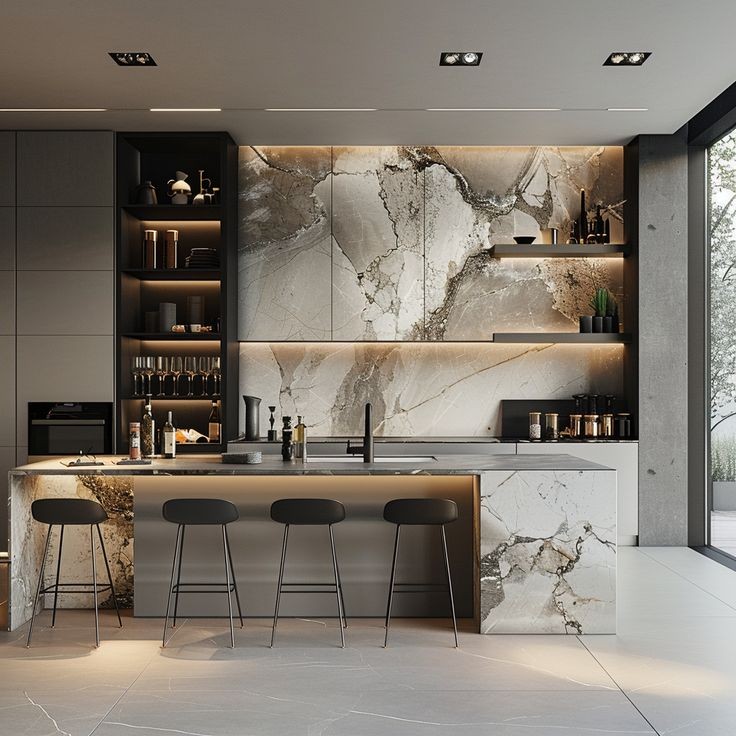Home Bar Corner Design: Functional, Aesthetic, and Ergonomic Solutions

Designing a home bar corner requires an arrangement that aligns with the overall atmosphere of the space, supports user habits, and is enhanced with aesthetic elements. A bar corner should not only be designed for preparing drinks but also as a space that encourages social interaction. In this context, factors such as material selection, dimensions, lighting, and ergonomics must be carefully considered.
Spatial Planning and Dimensions
The location of the bar corner should be evaluated in terms of user circulation and functionality, with a layout plan that does not disrupt the flow of the space. For a small-scale bar area, a minimum width of 120-150 cm is sufficient, while a larger bar setup requires 200 cm or more of space. The bar counter height should generally be between 105-110 cm for ergonomic use. The seating height for standard bar stools should be 75-80 cm. If the seating area is integrated into the bar counter, a 50-60 cm distance between stools should be maintained to ensure comfortable movement. Storage space is also one of the most important elements supporting functionality. Open shelves or closed cabinets with a depth of 35-40 cm are ideal for storing bottles, glasses, and cocktail equipment. If a wine storage section is planned, bottles should be stored horizontally for optimal conditions.
Material Selection and Textures
Material selection is one of the key factors in ensuring that the bar corner is both aesthetically pleasing and durable over time. Surfaces on the counter should be resistant to water and stains.
-
Natural Stone and Composite Materials: Marble, granite, and quartz surfaces are among the ideal choices for both durability and aesthetics. Stones such as Calacatta marble or Nero Marquina, with their dark tones, add a luxurious and sophisticated character to the space. Composite surfaces offer the advantage of low maintenance and high stain resistance.
-
Wood and Natural Finishes: Durable wood materials such as oak, walnut, or teak can be used to create a rustic and warm atmosphere. However, wood surfaces should be treated to protect them from liquid and heat.
-
Metal and Industrial Textures: Brass, matte black steel, or chrome details add a contemporary and industrial feel to the bar corner. Metal shelving systems, hanging glass holders, and framed details bring both elegance and functionality to the space.
-
Glass and Acrylic Surfaces: Glass shelves create a sense of lightness in the space, and when supported by LED lighting, they achieve a sophisticated look. Acrylic surfaces provide a shiny and smooth texture in a modern bar design.
Lighting and Atmosphere
Lighting is one of the most important elements that define the character of the bar corner. It should be planned both functionally and decoratively. In addition to general lighting, localized lighting solutions should be added for the counter and shelving systems.
-
Pendant Lamps: Pendant lamps with a diameter of 40-50 cm, placed above the counter, create a warm and inviting atmosphere. Industrial, modern, or classic designs should be chosen to match the overall style of the space.
-
LED Strip Lighting: LED lighting used inside shelves and under the bar counter enhances the space by adding depth and providing an aesthetic highlight. Warm white or amber tones create a more intimate atmosphere.
-
Spot Lighting: Recessed spotlights can be used in shelves displaying bottles and glasses to create a visual focal point.
Storage and Functionality
For the bar corner to operate efficiently, beverages and equipment must be stored in an organized manner. Open shelving systems allow for the display of bottles and glasses, while closed cabinets maintain an orderly appearance.
-
Bottle Storage: Wine bottles should be stored horizontally, while spirits should be stored vertically. Shelf depths should be adjusted to the size of the bottles, ensuring they are always easily accessible.
-
Glass Hangers: Integrated hanging systems for glasses on lower shelves offer both aesthetic appeal and convenience.
-
Under-Counter Mini Fridge: A mini fridge integrated into the bar area to store cold beverages and garnishes is an important detail that enhances functionality.
Style and Personalization
The bar corner should be completed with unique details that reflect the user's personal style. The space can be designed in modern, classic, rustic, or industrial styles.
-
Modern Style: Minimalist designs, straight lines, and monochrome color palettes create a simple and elegant bar corner. Glossy surfaces, metal details, and recessed lighting are key components of the modern style.
-
Classic and Luxury Style: Marble surfaces, dark wood accents, and brass accessories create a timeless and sophisticated atmosphere.
-
Rustic and Natural Style: A design supported by wood and stone textures, warm color palettes, and handmade details creates a rustic bar area.
Conclusion
Designing a home bar corner is a process that combines aesthetics, functionality, and ergonomics. Proper material selection, lighting planning, ergonomic dimensions, and storage solutions ensure that the space is both stylish and practical. A bar corner enriched with personal tastes and lifestyle details becomes not only a place for preparing drinks but also a key part of the home that fosters social interaction.
